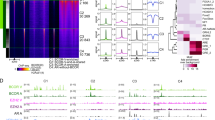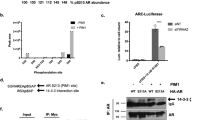Abstract
Transcriptional control by androgens via androgen receptor (AR) is strongly involved in prostate cancer development, but the critical target genes have remained elusive. We have characterized E twenty-six-like transcription factor 4 (ELK4) (also known as serum response factor accessory protein 1) as a novel AR target in human prostate cancer cells. In-silico screening identified three putative AR response elements (AREs) within −10 kb from the transcription start site of ELK4. Both ARE1 at −167/−153 and ARE2 at −481/−467 bound AR in vitro and mediated androgen induction as isolated elements in transcription assays in non-prostate cells. However, merely the ARE2 that cooperates with a proximal forkhead box A1-binding site was critical for the AR-dependent activation of ELK4 promoter in prostate cancer cells. Preferential loading of holo-AR onto the ARE2 and concomitant recruitment of RNA polymerase II onto the ELK4 promoter was confirmed in prostate cancer cells by chromatin immunoprecipitation. Database searches indicated that the expression of ELK4 is markedly increased in prostate cancers relative to normal prostates. Moreover, prostate cancer tissue immunostainings showed that nuclear ELK4 levels are significantly increased in androgen-refractory prostate cancers compared to untreated tumours. Reduction of the amount of ELK4 in LNCaP cells by RNAi retarded cell growth. In conclusion, ELK4 is a direct AR target in prostate cancer cells. Androgens may thus contribute to the growth of prostate cancer via influencing ELK4 levels.
This is a preview of subscription content, access via your institution
Access options
Subscribe to this journal
Receive 50 print issues and online access
$259.00 per year
only $5.18 per issue
Buy this article
- Purchase on Springer Link
- Instant access to full article PDF
Prices may be subject to local taxes which are calculated during checkout







Similar content being viewed by others
References
Ayadi A, Zheng H, Sobieszczuk P, Buchwalter G, Moerman P, Alitalo K et al. (2001). Net-targeted mutant mice develop a vascular phenotype and up-regulate egr-1. EMBO J 20: 5139–5152.
Buchwalter G, Gross C, Wasylyk B . (2004). Ets ternary complex transcription factors. Gene 324: 1–14.
Cesari F, Brecht S, Vintersten K, Vuong LG, Hofmann M, Klingel K et al. (2004). Mice deficient for the ets transcription factor elk-1 show normal immune responses and mildly impaired neuronal gene activation. Mol Cell Biol 24: 294–305.
Chen CD, Welsbie DS, Tran C, Baek SH, Chen R, Vessella R et al. (2004). Molecular determinants of resistance to antiandrogen therapy. Nat Med 10: 33–39.
Cleutjens KB, van der Korput HA, van Eekelen CC, van Rooij HC, Faber PW, Trapman J . (1997). An androgen response element in a far upstream enhancer region is essential for high, androgen-regulated activity of the prostate-specific antigen promoter. Mol Endocrinol 11: 148–161.
Cleutjens KB, van Eekelen CC, van der Korput HA, Brinkmann AO, Trapman J . (1996). Two androgen response regions cooperate in steroid hormone regulated activity of the prostate-specific antigen promoter. J Biol Chem 271: 6379–6388.
Costello PS, Nicolas RH, Watanabe Y, Rosewell I, Treisman R . (2004). Ternary complex factor SAP-1 is required for Erk-mediated thymocyte positive selection. Nat Immunol 5: 289–298.
Culig Z, Comuzzi B, Steiner H, Bartsch G, Hobisch A . (2004). Expression and function of androgen receptor coactivators in prostate cancer. J Steroid Biochem Mol Biol 92: 265–271.
Culig Z, Klocker H, Bartsch G, Hobisch A . (2002). Androgen receptors in prostate cancer. Endocr Relat Cancer 9: 155–170.
Dalton S, Treisman R . (1992). Characterization of SAP-1, a protein recruited by serum response factor to the c-fos serum response element. Cell 68: 597–612.
Edwards S, Campbell C, Flohr P, Shipley J, Giddings I, Te-Poele R et al. (2005). Expression analysis onto microarrays of randomly selected cDNA clones highlights HOXB13 as a marker of human prostate cancer. Br J Cancer 92: 376–381.
Feldman BJ, Feldman D . (2001). The development of androgen-independent prostate cancer. Nat Rev Cancer 1: 34–45.
Gao N, Zhang J, Rao MA, Case TC, Mirosevich J, Wang Y et al. (2003). The role of hepatocyte nuclear factor-3 alpha (Forkhead Box A1) and androgen receptor in transcriptional regulation of prostatic genes. Mol Endocrinol 17: 1484–1507.
Gregory CW, He B, Johnson RT, Ford OH, Mohler JL, French FS et al. (2001). A mechanism for androgen receptor-mediated prostate cancer recurrence after androgen deprivation therapy. Cancer Res 61: 4315–4319.
Han G, Buchanan G, Ittmann M, Harris JM, Yu X, Demayo FJ et al. (2005). Mutation of the androgen receptor causes oncogenic transformation of the prostate. Proc Natl Acad Sci USA 102: 1151–1156.
Heinlein CA, Chang C . (2002). The roles of androgen receptors and androgen-binding proteins in nongenomic androgen actions. Mol Endocrinol 16: 2181–2187.
Heinlein CA, Chang C . (2004). Androgen receptor in prostate cancer. Endocr Rev 25: 276–308.
Huggins C, Hodges GV . (1941). Studies on prostate cancer. I. The effect of castration, estrogen and androgen injections on serum phosphatases in metastatic carcinoma of the prostate. Cancer Res 1: 293–297.
Jackson AL, Burchard J, Leake D, Reynolds A, Schelter J, Guo J et al. (2006). Position-specific chemical modification of siRNAs reduces ‘off-target’ transcript silencing. RNA 12: 1197–1205.
Kallio PJ, Palvimo JJ, Mehto M, Jänne OA . (1994). Analysis of androgen receptor-DNA interactions with receptor proteins produced in insect cells. J Biol Chem 269: 11514–11522.
Kang Z, Jänne OA, Palvimo JJ . (2004). Coregulator recruitment and histone modifications in transcriptional regulation by the androgen receptor. Mol Endocrinol 18: 2633–2648.
Karvonen U, Jänne OA, Palvimo JJ . (2006). Androgen receptor regulates nuclear trafficking and nuclear domain residency of corepressor HDAC7 in a ligand-dependent fashion. Exp Cell Res 312: 3165–3183.
Kononen J, Bubendorf L, Kallioniemi A, Bärlund M, Schraml P, Leighton S et al. (1998). Tissue microarrays for high-throughput molecular profiling of tumor specimens. Nat Med 4: 844–847.
Linja MJ, Porkka KP, Kang Z, Savinainen KJ, Jänne OA, Tammela TL et al. (2004). Expression of androgen receptor coregulators in prostate cancer. Clin Cancer Res 10: 1032–1040.
Linja MJ, Savinainen KJ, Saramäki OR, Tammela TL, Vessella RL, Visakorpi T . (2001). Amplification and overexpression of androgen receptor gene in hormone-refractory prostate cancer. Cancer Res 61: 3550–3555.
Luo J, Duggan DJ, Chen Y, Sauvageot J, Ewing CM, Bittner ML et al. (2001). Human prostate cancer and benign prostatic hyperplasia: molecular dissection by gene expression profiling. Cancer Res 61: 4683–4688.
Magee JA, Araki T, Patil S, Ehrig T, True L, Humphrey PA et al. (2001). Expression profiling reveals hepsin overexpression in prostate cancer. Cancer Res 61: 5692–5696.
Maroni PD, Crawford ED . (2006). Screening for prostate cancer in 2006: PSA in the 21st century. NC Med J 67: 136–139.
Oettgen P, Finger E, Sun Z, Akbarali Y, Thamrongsak U, Boltax J et al. (2000). PDEF, a novel prostate epithelium-specific ets transcription factor, interacts with the androgen receptor and activates prostate-specific antigen gene expression. J Biol Chem 275: 1216–1225.
Palvimo JJ, Kallio PJ, Ikonen T, Mehto M, Jänne OA . (1993). Dominant negative regulation of trans-activation by the rat androgen receptor: roles of the N-terminal domain and heterodimer formation. Mol Endocrinol 7: 1399–1407.
Riegman PH, Vlietstra RJ, van der Korput HA, Romijn JC, Trapman J . (1991). Identification and androgen-regulated expression of two major human glandular kallikrein-1 (hGK-1) mRNA species. Mol Cell Endocrinol 76: 181–190.
Schuur ER, Henderson GA, Kmetec LA, Miller JD, Lamparski HG, Henderson DR . (1996). Prostate-specific antigen expression is regulated by an upstream enhancer. J Biol Chem 271: 7043–7051.
Shaulian E, Karin M . (2002). AP-1 as a regulator of cell life and death. Nat Cell Biol 4: 131–136.
Shaw PE, Saxton J . (2003). Ternary complex factors: prime nuclear targets for mitogen-activated protein kinases. Int J Biochem Cell Biol 35: 1210–1226.
Stewart AB, Lwaleed BA, Douglas DA, Birch BR . (2005). Current drug therapy for prostate cancer: an overview. Curr Med Chem Anticancer Agents 5: 603–612.
Taplin ME, Bubley GJ, Shuster TD, Frantz ME, Spooner AE, Ogata GK et al. (1995). Mutation of the androgen-receptor gene in metastatic androgen-independent prostate cancer. N Engl J Med 332: 1393–1398.
Thompson J, Saatcioglu F, Jänne OA, Palvimo JJ . (2001). Disrupted amino- and carboxyl-terminal interactions of the androgen receptor are linked to androgen insensitivity. Mol Endocrinol 15: 923–935.
Tomlins SA, Mehra R, Rhodes DR, Cao X, Wang L, Dhanasekaran SM et al. (2007). Integrative molecular concept modeling of prostate cancer progression. Nat Genet 39: 41–51.
Tomlins SA, Mehra R, Rhodes DR, Smith LR, Roulston D, Helgeson BE et al. (2006). TMPRSS2:ETV4 gene fusions define a third molecular subtype of prostate cancer. Cancer Res 66: 3396–3400.
Tomlins SA, Rhodes DR, Perner S, Dhanasekaran SM, Mehra R, Sun XW et al. (2005). Recurrent fusion of TMPRSS2 and ETS transcription factor genes in prostate cancer. Science 310: 644–648.
Wang Q, Li W, Liu XS, Carroll JS, Jänne OA, Keeton EK et al. (2007). A hierarchical network of transcription factors governs androgen receptor-dependent prostate cancer growth. Mol Cell 27: 380–392.
Welsh JB, Sapinoso LM, Su AI, Kern SG, Wang-Rodriguez J, Frierson HF et al. (2001). Analysis of gene expression identifies candidate markers and pharmacological targets in prostate cancer. Cancer Res 61: 5974–5978.
Visakorpi T, Hyytinen E, Koivisto P, Tanner M, Keinänen R, Palmberg C et al. (1995). In vivo amplification of the androgen receptor gene and progression of human prostate cancer. Nat Genet 9: 401–406.
Xiao D, Qu X, Weber HC . (2002). GRP receptor-mediated immediate early gene expression and transcription factor Elk-1 activation in prostate cancer cells. Regul Pept 109: 141–148.
Yu YP, Landsittel D, Jing L, Nelson J, Ren B, Liu L et al. (2004). Gene expression alterations in prostate cancer predicting tumour aggression and preceding development of malignancy. J Clin Oncol 22: 2790–2799.
Zheng H, Wasylyk C, Ayadi A, Abecassis J, Schalken JA, Rogatsch H et al. (2003). The transcription factor Net regulates the angiogenic switch. Genes Dev 17: 2283–2297.
Acknowledgements
This work was supported by grants from the Academy of Finland, Association for International Cancer Research, Finnish Cancer Foundation, Sigrid Jusélius Foundation, Kuopio Naturalists’ Society, Helena Vuorenmies Foundation, Karjalan Sivistysseura and Finnish Union of Experts in Science. We thank Merja Räsänen for skilful technical assistance.
Author information
Authors and Affiliations
Corresponding author
Additional information
Supplementary Information accompanies the paper on the Oncogene website (http://www.nature.com/onc).
Supplementary information
Rights and permissions
About this article
Cite this article
Makkonen, H., Jääskeläinen, T., Pitkänen-Arsiola, T. et al. Identification of ETS-like transcription factor 4 as a novel androgen receptor target in prostate cancer cells. Oncogene 27, 4865–4876 (2008). https://doi.org/10.1038/onc.2008.125
Received:
Revised:
Accepted:
Published:
Issue Date:
DOI: https://doi.org/10.1038/onc.2008.125
Keywords
This article is cited by
-
Hsa_circ_0119412 Contributes to Development of Retinoblastoma by Targeting miR-186-5p/ELK4 Axis
Molecular Biotechnology (2023)
-
ELK4-mediated lncRNA SNHG22 promotes gastric cancer progression through interacting with EZH2 and regulating miR-200c-3p/Notch1 axis
Cell Death & Disease (2021)
-
Fusion transcript detection using spatial transcriptomics
BMC Medical Genomics (2020)
-
The expression of AURKA is androgen regulated in castration-resistant prostate cancer
Scientific Reports (2017)
-
Tumor features and survival after radical prostatectomy among antidiabetic drug users
Prostate Cancer and Prostatic Diseases (2016)



